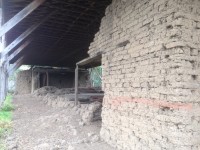What do the Grateful Dead, Bear Flag Revolt, The Chosen Family, 8,000 year old Native American site, a Victorian estate, Camilo Ynitia and George McKale all have in common: Olompali State Historic Park.
If you have never visited Olompali, there’s never been a better time than this Sunday. This year’s 29th annual Heritage Day, will host numerous organizations whose goals are to share both the cultural and natural history of the parks incredible resources. There will be entertainment for all age groups and the best part of all, free ice cream cones!
Heritage Day visitors can take guided walks to learn about Olompali’s birds, plants, and archaeology. They also can hear experts discuss the park’s historic structures, including the Camilo Ynitia Adobe, the Burdell Mansion and the Burdell Victorian Garden. Pomo Elder Nick Tipon and I will giving an archaeology walk and talk beginning at 11:00. Also, returning this year will be Senior State Parks Archaeologist Breck Parkman, who will discuss Olompali’s rich archaeological history.
Throughout the day there will be family-oriented interactive demonstrations of basketry, flint-knapping, adobe brick making, and blacksmithing. Tacos, burritos and other tasty Mexican food will be available for purchase and there will be free ice cream cones, courtesy of Straus Family Creamery. The event will be from 10 a.m. to 4 p.m., admission is free and parking is $8.
Olompali has one of the most interesting histories in the State of California. Its catalog of important cultural resources reads like a rap sheet from one of the 10 most wanted. It has one of the largest prehistoric Miwok sites in California, the only adobe in Marin County, the Burdell-era 1866 Clapboard House, 1911 stucco mansion, late 19th century outbuildings, Victorian garden complete with exotic plants, and a “hippie” commune.
Olompali was a very large Coast Miwok village site, intermittently occupied for around 8,000 years, and continuously occupied since 500 A.D. Camilo Ynitia was a Coast Miwok, probably born at the village of Olompali in 1803, and considered the last Hoipu (headman). Accounts vary, but some believe that Camilo constructed his adobe in 1837 at Olompali, attaching an “L” shape to the building in 1840. Mariano Vallejo and Camilo became friends, and in 1843, Vallejo petitioned Governor Micheltorena to grant 8,900 acres to Camilo. Camilo had the distinction of being the only Native American in northern California to have such a land title confirmed by the U.S. Land Commission.
Sonoma residents are quite aware of the Bear Flag revolt in 1846 and the arrest of Marino Vallejo on June 14. What is not so common knowledge is the June 24 “Battle of Olompali” when a fight broke out between American Bear Flaggers stationed in Sonoma and a Mexican force of 50 men under the command of Joaquin de la Toree near Camilo’s adobe. The story goes that several men were wounded and one man killed, the only fatality associated with the brief uprising.
In 1852, Camilo sold most of his land to James Black, Marin County’s first tax assessor. Black gave Rancho Olompali to his daughter Mary as a wedding gift when she married Galen Burdell, one of San Francisco’s first dentists. Mary Burdell developed an exquisite Victorian garden in 1866. Many of the plants were collected from a trip to Japan in 1874. The Burdells sold the property in 1943 to Count Harrington and a short time later it was sold to the University of San Francisco.
The ranch was leased to various tenants during the “summer of love,” including rock legends Janis Joplin, Grace Slick, and the Grateful Dead. Local businessmen, Don McCoy leased Olompali in 1967, creating a utopian commune known as “The Chosen Family.” The State of California purchased the unique property in 1977. I hope to see you there.


Be First to Comment